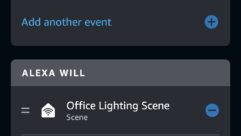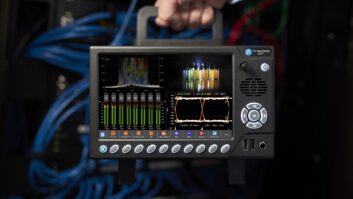
Aphex 230 Master Voice Channel
Oct 1, 2007 12:00 PM,
By John McJunkin
A straightforward and affordable audio processor.

Television, radio, and satellite announcer voices need to sound absolutely brilliant — polished, intimate, punchy, and above all, clear. Broadcast engineers have worked hard over the years to improve and enhance voice quality. The result, in many cases, has been a rack full of equipment. A typical system features a mic pre, compression, limiting, equalization, and perhaps some kind of maximizer- or exciter-type device to enhance clarity and loudness. And more recently, a nice analog-to-digital converter may be included. One problem with this rig, of course, is that it usually fills a whole backbreaking rack!
In recent years, Swiss Army knife-style devices have appeared — boxes including at least a mic pre, compressor, and an equalizer. The obvious advantage is having multiple processors in a lighter, less-unwieldy package. But putting multiple processors in a single box may result in dodgy quality. And that’s not a disparaging remark — the consolidation of thousands of dollars worth of processors into a single box requires some corner-cutting. It’s hard to mass-market a 1RU device for $10,000, after all.
Bottom line: Some “all-in-one” boxes are better than others. In some cases, the manufacturer chooses not to skimp, and each stage of the processor is a quality device that stands on its own. I had heard excellent things from colleagues about the Aphex 230 Master Voice Channel, so I wanted to get my hands on one to find out for myself, and I recently did just that.
Let’s take a quick tour through the Aphex 230 signal chain. First stop: the mic pre. This is a high-quality tube (12AT7/ECC81) preamp that features a 20dB pad, a gain control, 48V phantom power, polarity inversion, and a 12dB/octave low-cut filter at 70Hz. It’s quiet and sounds great.
The Aphex Phase Rotator circuit comes next in the chain. This unique process reduces the compression-wrecking natural amplitude asymmetry of the human voice, increasing intelligibility and apparent loudness. Aphex warns that it sounds weird if you are monitoring yourself in headphones (and it does), but the recorded signal sounds great if there is a lot of asymmetry in a voice.
Next up is the Easyrider compressor. The mic pre’s gain control is used as a drive control for the compressor, and the only other controls determine the length of the release and whether the compressor is inserted into the signal path at all. It sounds great, which is no surprise. The ratio is fixed at 4:1 — right about where I like voice compression — and it sports a medium hard knee. It’s a no-muss, no-fuss solution that works well if you don’t need to tweak a lot.
The Logic-assisted Gate comes next in the path, with controls for threshold and depth. Its attack, hold, and release are fixed at 0.1 millisecond, 300 milliseconds, and 400 milliseconds, respectively. Again, no joy for knob-tweakers, but it’s a practical compromise that yields non-chattering gating with no muss or fuss.
Next along is a de-esser with a single control: threshold level. Many de-essers duck the entire signal with every occurrence of sibilance, but the Aphex de-esser only ducks the sibilance itself, using Linkwitz-Riley filters to split the signal at 5kHz. The de-esser is a great example of how Aphex has chosen to include excellent technology at every stage, not skimping anywhere.
Following the de-esser is the equalizer block, including a fully parametric EQ and two of Aphex’s famous proprietary processors, Big Bottom and the Aural Exciter. There is a single switch that toggles this entire block on or off. Big Bottom comes first, and it essentially augments low-end — a great addition for guys like me who have so-so pipes but who wish to achieve Don LaFontaine levels of gravitas. I don’t have Don’s gift of diction and inflection, but Big Bottom sure helps my pipes. The parametric EQ lives between the Big Bottom and Exciter, and it is very familiar and straightforward. It’s probably best to use it for scooping mids or other annoying frequencies. The Aural Exciter provides controls for Tune, which adjusts between Presence and Air, and Mix, which adjusts effect level. The Exciter very nicely promotes intelligibility.
There is a single output-level knob representing the final stage of the signal chain. The unit’s front panel also features a really nice 10-segment LED meter that can represent either overall output level or the compressor’s gain reduction. Aphex recommends setting output level such that the top peaks never get over -6dBFS. I agree with this wholeheartedly. Although, in today’s level wars, it may be tempting to disregard this advice. I hope we can all settle down and stop striving for quantity and get back to striving for quality.
There is one other piece of advice from Aphex with which I agree: Use the inserts of your console whenever you use an outboard front-end device. If you don’t already, start now. Even line-in connections are possibly passing your signal through noise-increasing (and distorting) circuits. Physically bypassing those circuits by getting in through an insert (whenever possible) is preferable. OK, now I’ll come down from my soapbox.
The Aphex 230 has a single XLR mic input and both XLR (balanced) and 1/4in. TRS (unbalanced) analog outputs. It also sports AES3 and both RCA coaxial and optical Toslink S/PDIF digital outputs. The back panel also features an effects insert located between the dynamics and EQ sections, along with a cough switch jack, BNC word clock I/O, and switches that determine sample rate.
I used the Aphex 230 for a couple of purposes, and I became acutely aware of how useful it would be for other applications, as well. I have a podcast production firm, and I have been very happy with my existing processing sequence, so I was anxious to record my voice and compare. I plugged my favorite large-diaphragm condenser mic into the 230 and tweaked away. It took me no time at all to arrive at a new, higher level of quality. My delivery really came through clearly and with punch.
I also used the 230 to record a female vocal. It worked very nicely for this purpose as well, facilitating a necessary bit of de-essing and EQ. It is clear to me that this box would also be eminently useful in live sound, delivering a well-sculpted, consistent vocal output to the console. Also, in business communications, the voices in a board meeting, conference call, or any other similar situation would benefit immensely from the 230.
I’m not afraid of using plenty of processing to arrive at the full, punchy, clear voice necessary for podcast production, but the time required for me to accomplish this in my DAW after the fact could be better spent. I love it that the signal coming out of the 230 requires no further work. It’s 100-percent complete, ready to go. It’s easy to think, “Gosh, I’ve already got great processors,” but again, a rack full of hardware breaks your back, and a computer full of plug-ins breaks the bank. And another nicety — I have hundreds of processing algorithms, but not a single phase rotator to be found, and this process contributes substantially.
The Aphex 230 is vastly more straightforward and affordable than any comparable solution and, considering the price, a complete no-brainer. It’s simply spectacular for broadcast (and podcast) production.
PRODUCT SUMMARY
Company: Aphex Systems
www.aphex.com
Product: Aphex 230 Master Voice Channel
Pros: Clever consolidation of quality processors.
Cons: None.
Applications: Broadcast production, live sound, corporate communications.
Price: $799
SPECIFICATIONS
Input
Impedance: 2kΩ
Maximum input: 0dBu
Nominal preamp gain: 20dB to 65dB
EIN: -127dBu (input shorted)
Analog output
Impedance (balanced): 66Ω
Impedance (unbalanced): XLR: 33Ω; TRS: 600Ω
Nominal level: XLR: +4dBu; TRS: -10dBV
Maximum output: XLR: +25dBu (unloaded); TRS: +11dBV
Analog audio
THD: <0.01% @ +4dBu out
IMD: <0.01% @ +4dBu out
Frequency response: 18Hz to 24kHz ±1dB
Digital audio
Internal sample rates: 44.1kHz, 48kHz, 88.2kHz, 96kHz
External sample rates: Automatic sync, any rate between 32kHz and 96kHz
Resolution: 24 bits
Level equivalency: -20dBFS digital = +4dBu analog
John McJunkinis the principal of Avalon Podcasting in Chandler, Ariz. He has consulted in the development of studios and installations and provides high-quality podcast production services.










